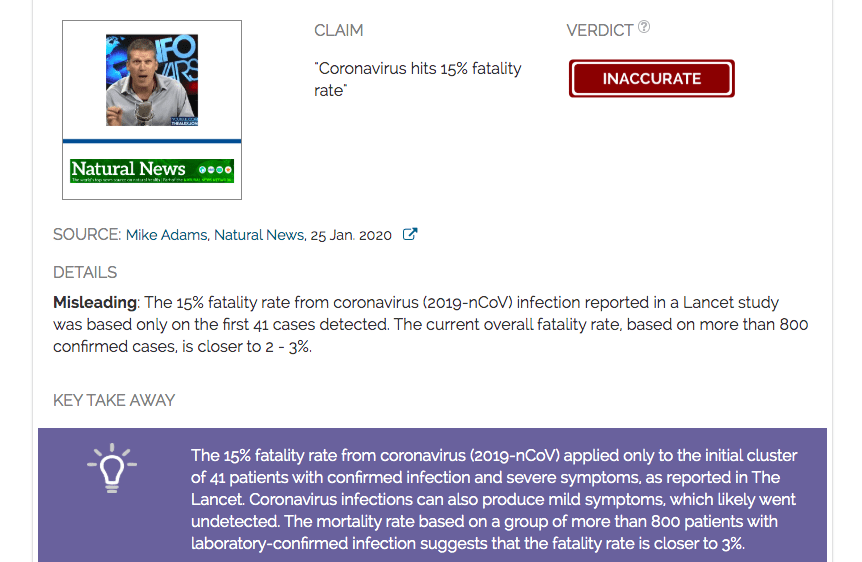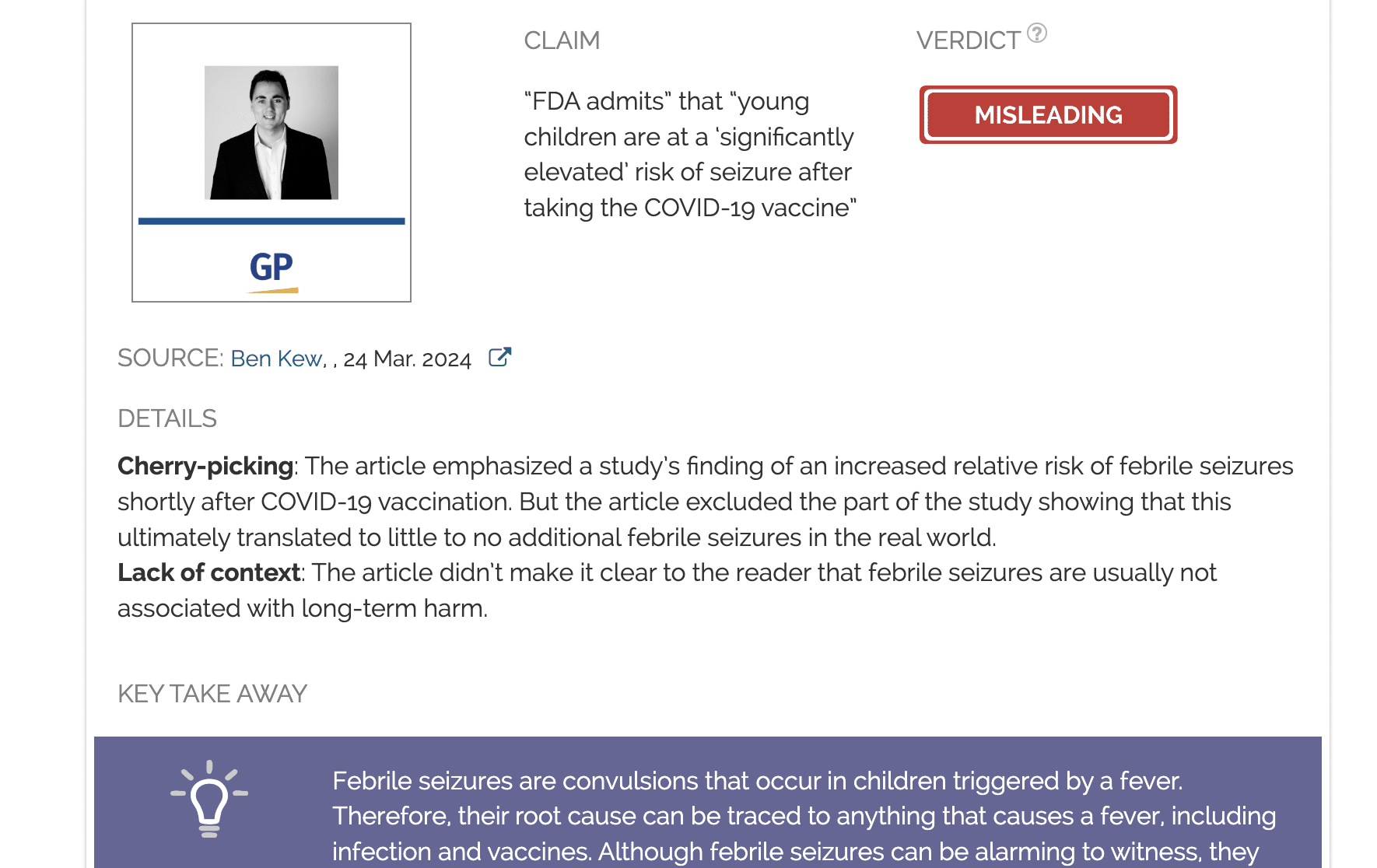- Health
“15% fatality rate” from coronavirus (2019-nCoV) infection was based only on initial cases; infection fatality rate likely less than 3%
Key takeaway
The 15% fatality rate from coronavirus (2019-nCoV) applied only to the initial cluster of 41 patients with confirmed infection and severe symptoms, as reported in The Lancet. Coronavirus infections can also produce mild symptoms, which likely went undetected. Findings from a study of more than 800 patients with laboratory-confirmed infection and another study with more than 44,000 confirmed cases show the case fatality rate (CFR) ranges between 1 to 3%.
Reviewed content

Verdict:
Claim:
Coronavirus hits 15% fatality rate
Verdict detail
Misleading: The 15% fatality rate from coronavirus (2019-nCoV) infection reported in a Lancet study was based only on the first 41 cases detected. The case fatality rate, based on a study of more than 800 confirmed cases and another study with more than 44,000 cases, is closer to 1 - 3%.
Full Claim
Coronavirus hits 15% fatality rate
Review
The article containing this claim was published on 25 January 2020. The headline claims that the novel coronavirus from Wuhan, China, provisionally named 2019-nCoV, causes a 15% fatality rate.
The article bases its claim on a study published January 2020 in The Lancet, which examined the clinical features and outcomes of 2019-nCoV infection in the first cluster of 41 cases[1]. Six people in this initial cohort died, bringing the case fatality rate to approximately 15%. The case fatality rate (CFR) is determined by the number of deaths among all laboratory-confirmed cases of COVID-19.
However, these initial cases were only detected because the patients experienced severe symptoms. Infection with 2019-nCoV can also produce mild illness and symptoms of the common cold or flu. Patients with mild symptoms are less likely to seek medical attention and therefore less likely to be definitively diagnosed. Therefore, the 15% fatality rate is likely an overestimation.
Dr. William Schaffner, a professor of preventive medicine and infectious diseases at Vanderbilt University Medical Center, explained this phenomenon in a recent New York Times article:
“When we get a new infectious disease, we learn about the most severe cases first, the top of the pyramid as it were […] As the investigation goes on, we often learn there are less severely infected people, and even people who are infected who don’t get sick at all.”
An estimate of overall mortality, rather than simply initial mortality, was published on 24 January 2020, and was based on data from more than 800 confirmed cases. In this cohort, 25 patients died, bringing the case fatality rate closer to 3%[2]. A New York Times article published on 31 January 2020 also reports the same estimate.
A 24 January commentary in The Lancet explained that any estimates of fatality “should be treated with great caution because not all patients have concluded their illness (i.e., recovered or died) and the true number of infections and full disease spectrum are unknown.”
Because the outbreak is still underway, and many infections have yet to be discovered or have not concluded, the exact mortality from 2019-nCoV is unknown. However, it is very likely much lower than 15%.
Indeed, a later study by Verity et al. in The Lancet Infectious Diseases[3], published on 30 March 2020, showed an overall case fatality ratio of approximately 1.4% for more than 44,000 cases in China across all age groups. However, the overall infection fatality ratio, or number of deaths among the estimated number of total infections which includes both undetected and lab-confirmed cases, across all age groups was approximately 0.7%. This is expected, as many cases of COVID-19 are believed to be asymptomatic or mild, and were not tested. Therefore, the overall infection fatality ratio is likely much lower than the CFR.
While it is important to be vigilant during this outbreak, it is also necessary to put the dangers of the new coronavirus in perspective. For example, influenza has existed for much longer than 2019-nCoV and thus has had more global impact, yet the public in general remains unconcerned about the seasonal flu. This is in spite of a report by the U.S. Centers for Disease Control and Prevention (CDC) estimating that the seasonal flu “has resulted in between 9 million – 45 million illnesses, between 140,000 – 810,000 hospitalizations, and between 12,000 – 61,000 deaths annually since 2010.”
[Scientific research on 2019-nCoV is ongoing. This review will be updated as new information becomes available.]
This review was updated with new findings from a study by Verity et al. in The Lancet Infectious Diseases[3], showing an overall case fatality ratio (CFR) of approximately 1.4% for more than 44,000 cases in China across all age groups. CFR is defined as the number of deaths among laboratory-confirmed cases of COVID-19. The overall infection fatality ratio or number of deaths among the estimated number of total infections, which includes both undetected and lab-confirmed cases, across all age groups, was approximately 0.7%.
REFERENCES
- 1 – Huang et al. (2020) Clinical features of patients infected with 2019 novel coronavirus in Wuhan, China. The Lancet.
- 2 – Wang et al. (2020) A novel coronavirus outbreak of global health concern. The Lancet.
- 3 – Verity et al. (2020) Estimates of the severity of coronavirus disease 2019: a model-based analysis. The Lancet Infectious Diseases.



